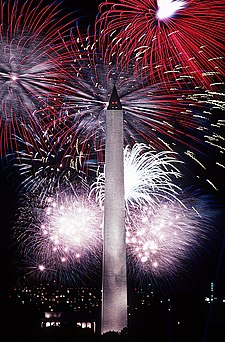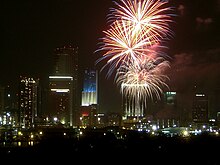From Wikipedia, the free encyclopedia
| Independence Day | |
|---|---|
| Also called | The Fourth of July The Glorious Fourth The Fourth |
| Observed by | |
| Type | National |
| Significance | The day the Declaration of Independence was adopted by the Continental Congress |
| Date | (2011) Monday, July 4 |
| Celebrations | |
Independence Day, commonly known as the Fourth of July, is a federal holiday in the United States commemorating the adoption of the Declaration of Independence on July 4, 1776, declaring independence from the Kingdom of Great Britain. Independence Day is commonly associated with fireworks, parades, barbecues, carnivals, fairs, picnics, concerts, baseball games, family reunions, political speeches and ceremonies, and various other public and private events celebrating the history, government, and traditions of the United States. Independence Day is the national day of the United States.
Background
During the American Revolution, the legal separation of the Thirteen Colonies from Great Britain occurred on July 2, 1776, when the Second Continental Congress voted to approve a resolution of independence that had been proposed in June by Richard Henry Lee of Virginia. After voting for independence, Congress turned its attention to the Declaration of Independence, a statement explaining this decision, which had been prepared by a Committee of Five, with Thomas Jefferson as its principal author. Congress debated and revised the Declaration, finally approving it on July 4. A day earlier, John Adams had written to his wife Abigail:
The second day of July, 1776, will be the most memorable epoch in the history of America. I am apt to believe that it will be celebrated by succeeding generations as the great anniversary festival. It ought to be commemorated as the day of deliverance, by solemn acts of devotion to God Almighty. It ought to be solemnized with pomp and parade, with shows, games, sports, guns, bells, bonfires, and illuminations, from one end of this continent to the other, from this time forward forever more.
Adams's prediction was off by two days. From the outset, Americans celebrated independence on July 4, the date shown on the much-publicized Declaration of Independence, rather than on July 2, the date the resolution of independence was approved in a closed session of Congress.
Historians have long disputed whether Congress actually signed the Declaration of Independence on July 4, even though Thomas Jefferson, John Adams, and Benjamin Franklin all later wrote that they had signed it on that day. Most historians have concluded that the Declaration was signed nearly a month after its adoption, on August 2, 1776, and not on July 4 as is commonly believed.
In a remarkable coincidence, both John Adams and Thomas Jefferson, the only signers of the Declaration of Independence later to serve as Presidents of the United States, died on the same day: July 4, 1826, which was the 50th anniversary of the Declaration. Although not a signer of the Declaration of Independence, James Monroe, the Fifth President of the United States, died on July 4, 1831. Calvin Coolidge, the Thirtieth President, was born on July 4,1872, and thus was the only President to be born on Independence Day.
Observance
An 1825 invitation to an Independence Day celebration
- In 1777, thirteen gunshots were fired, once at morning and again as evening fell, on July 4 in Bristol, Rhode Island. Philadelphia celebrated the first anniversary in a manner a modern American would find quite familiar: an official dinner for the Continental Congress, toasts, 13-gun salutes, speeches, prayers, music, parades, troop reviews, and fireworks. Ships were decked with red, white, and blue bunting.
- In 1778, General George Washington marked July 4 with a double ration of rum for his soldiers and an artillery salute. Across the Atlantic Ocean,ambassadors John Adams and Benjamin Franklin held a dinner for their fellow Americans in Paris, France.
- In 1779, July 4 fell on a Sunday. The holiday was celebrated on Monday, July 5.
- In 1781, the Massachusetts General Court became the first state legislature to recognize July 4 as a state celebration.
- In 1783, Moravians in Salem, North Carolina, held a celebration of July 4 with a challenging music program assembled by Johann Friedrich Peter. This work was titled "The Psalm of Joy".
- In 1791 the first recorded use of the name "Independence Day" occurred.
- In 1820 the first Fourth of July celebration was held in Eastport, Maine which remains the largest in the state.
- In 1938, Congress changed Independence Day to a paid federal holiday.
Customs
In addition to a fireworks show, Miamilights one of its tallest buildings with the patriotic red, white and blue color schemeon Independence Day
New York City's fireworks display, shown above over the East Village, is sponsored by Macy's and the largest[18] in the country
Patriotic trailer shown in theaters prior to the 4th of July 1940
Independence Day is a national holiday marked by patriotic displays. Similar to other summer-themed events, Independence Day celebrations often take place outdoors. Independence Day is a federal holiday, so all non-essential federal institutions (like the postal service and federal courts) are closed on that day. Many politicians make it a point on this day to appear at a public event to praise the nation's heritage, laws, history, society, and people.
Families often celebrate Independence Day by hosting or attending a picnic or barbecue and take advantage of the day off and, in some years, long weekend to gather with relatives. Decorations (e.g., streamers, balloons, and clothing) are generally colored red, white, and blue, the colors of the American flag. Parades often are in the morning, while fireworks displays occur in the evening at such places as parks, fairgrounds, or town squares.
Independence Day fireworks are often accompanied by patriotic songs such as the national anthem "The Star-Spangled Banner", "God Bless America", "America the Beautiful", "My Country, 'Tis of Thee", "This Land Is Your Land", "Stars and Stripes Forever", and, regionally, "Yankee Doodle" in northeastern states and "Dixie" in southern states. Some of the lyrics recall images of the Revolutionary War or the War of 1812.
Firework shows are held in many states, and many fireworks are sold for personal use or as an alternative to a public show. Safety concerns have led some states to ban fireworks or limit the sizes and types allowed. Illicit traffic transfers many fireworks from less restrictive states.
A salute of one gun for each state in the United States, called a “salute to the union,” is fired on Independence Day at noon by any capable military base.
In 2009, New York City had the largest fireworks display in the country, with over 22 tons of pyrotechnics exploded.[18] Other major displays are in Chicago onLake Michigan; in San Diego over Mission Bay; in Boston on the Charles River; in St. Louis on the Mississippi River; in San Francisco over the San Francisco Bay; and on the National Mall in Washington, D.C..
July 4 party table arrangement
During the annual Windsor-Detroit International Freedom Festival, Detroit, Michigan hosts one of the world's largest fireworks displays, over the Detroit River, to celebrate Independence Day in conjunction with Windsor, Ontario's celebration of Canada Day.
While the official observance always falls on July 4th, participation levels may vary according to which day of the week the 4th falls on. If the holiday falls in the middle of the week, some fireworks displays and celebrations may take place during the weekend for convenience, again, varying by region.
The first week of July is typically one of the busiest American travel periods of the year, as many people utilize the holiday for extended vacation trips.
Unique or historical celebrations
Originally entitled Yankee Doodle, this is one of several versions of a scene painted by A. M. Willard that came to be known asThe Spirit of '76. Often imitated or parodied, it is a familiar symbol of American patriotism
- Held since 1785, the Bristol Fourth of July Parade in Bristol, Rhode Island is the oldest continuous Independence Day celebration in the United States.
- Since 1916, Nathan's Hot Dog Eating Contest in Coney Island, Brooklyn, New York City supposedly started as a way to settle a dispute among four immigrants as to who was the most patriotic.
- Since 1959, the International Freedom Festival is jointly held in Detroit, Michigan and Windsor, Ontario during the last week of June each year as a mutual celebration of Independence Day and Canada Day (July 1). It culminates in a large fireworks display over the Detroit River.
- The famous Macy's fireworks display usually held over the East River in New York City has been televised nationwide on NBC since 1976. In 2009, the fireworks display was returned to the Hudson River for the first time since 2000 to commemorate the 400th anniversary of Henry Hudson's exploration of that river.[22]
- The Boston Pops Orchestra has hosted a music and fireworks show over the Charles River Esplanade called the "Boston Pops Fireworks Spectacular" annually since 1973.[23] The event was broadcast nationally from 1987 until 2002 on the A&E Network, and has aired since 2003 on CBS.[24]
- On the Capitol lawn in Washington, D.C., “A Capitol Fourth,” a free concert, precedes the fireworks and attracts over half a million people annually.






